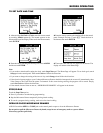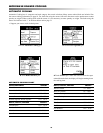
15
need tenderizing. DO NOT use metal twist ties. Remember
to slit bag so steam can escape.
How to use aluminum foil in your Microwave Drawer:
• Small flat pieces of aluminum foil placed smoothly on the
food can be used to shield areas that are either defrosting or
cooking too quickly.
• Foil should not come closer than one inch to any surface
of the Microwave Drawer.
Should you have questions about utensils or coverings, check
a good microwave cookbook or follow recipe suggestions.
ACCESSORIES There are many microwave accessories
available for purchase. Evaluate carefully before you purchase
so that they meet your needs. A microwave-safe thermometer
will assist you in determining correct doneness and assure
you that foods have been cooked to safe temperatures. Sharp
is not responsible for any damage to the Microwave Drawer
when accessories are used.
ABOUT CHILDREN AND THE MICROWAVE
Children below the age of 7 should use the Microwave
Drawer with a supervising person very near to them.
Between the ages of 7 and 12, the supervising person should
be in the same room.
The child must be able to reach the Microwave Drawer
comfortably.
At no time should anyone be allowed to lean or swing on the
Microwave Drawer.
Children should be taught all safety precautions: use
potholders, remove coverings carefully, pay special attention
to packages that crisp food because they may be extra hot.
Don’t assume that because a child has mastered one cooking
skill he/she can cook everything.
Children need to learn that the Microwave Drawer is not a
toy. See page 27 for Control Lock feature.
ABOUT SAFETY
• Check foods to see that they are cooked to the United States
Department of Agriculture’s recommended temperatures.
160˚F - For fresh pork, ground meat, boneless white poultry,
fish, seafood, egg dishes and frozen prepared food.
165˚F - For leftover, ready-to-reheat refrigerated, and deli and
carry-out “fresh” food.
170˚F - White meat of poultry.
180˚F - Dark meat of poultry.
To test for doneness, insert a meat thermometer in a thick
or dense area away from fat or bone. NEVER leave the
thermometer in the food during cooking, unless it is approved
for microwave use.
• ALWAYS use potholders to prevent burns when removing
heated food from the Microwave Drawer or handling utensils
that are in contact with hot food. Enough heat from the
food can transfer through utensils and to the bottom of the
Microwave Drawer to cause skin burns.
• Avoid steam burns by directing steam away from the face
and hands. Slowly lift the farthest edge of a dish’s covering
and carefully open popcorn and oven cooking bags away
from the face.
• Stay near the Microwave Drawer while it’s in use and
check cooking progress frequently so that there is no chance
of overcooking food.
• NEVER use the Microwave Drawer for storing cookbooks
or other items.
• Select, store and handle food carefully to preserve its high
quality and minimize the spread of foodborne bacteria.
• Keep waveguide cover clean. Food residue can cause arcing
and/or fires. See page 30.
ABOUT FOODS
FOOD DO DON’T
Eggs,
sausages,
fruits &
vegetables
• Puncture egg yolks
before cooking to prevent
“explosion”.
• Pierce skins of potatoes,
apples, squash, hot dogs
and sausages so that steam
escapes.
• Cook eggs in
shells.
• Reheat whole
eggs.
• Dry nuts or
seeds in shells.
Popcorn
• Use specially bagged
popcorn for the microwave.
• Listen while popping corn
for the popping to slow to 1
or 2 seconds or use special
Popcorn pad.
• Pop popcorn in
regular brown
bags or glass
bowls.
• Exceed
maximum time
on popcorn
package.
Baby
food
• Transfer baby food to small
dish and heat carefully,
stirring often. Check
temperature before serving.
• Put nipples on bottles
after heating and shake
thoroughly. “Wrist” test
before feeding.
• Heat disposable
bottles.
• Heat bottles
with nipples on.
• Heat baby food
in original jars.
General
• Cut baked goods with
filling after heating to
release steam and avoid
burns.
• Stir liquids briskly before
and after heating to avoid
“eruption”.
• Use deep bowl, when
cooking liquids or cereals,
to prevent boilovers.
• Food should be shorter than
the Microwave Drawer.
Please refer to the height of
side walls of the drawer.
• Heat or cook
in closed glass
jars or airtight
containers.
• Can in the
microwave
as harmful
bacteria
may not be
destroyed.
• Deep fat fry.
• Dry wood,
gourds, herbs
or wet papers.
MICROWAVE DRAWER COOKING


















